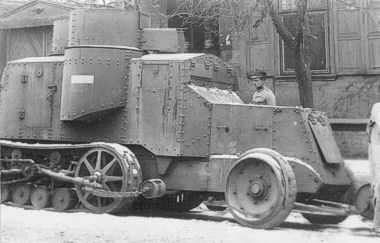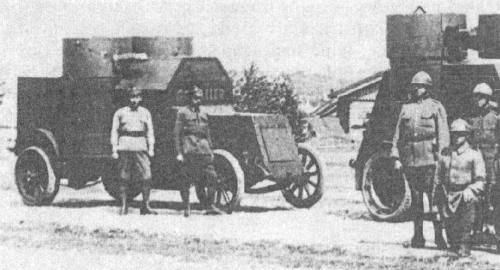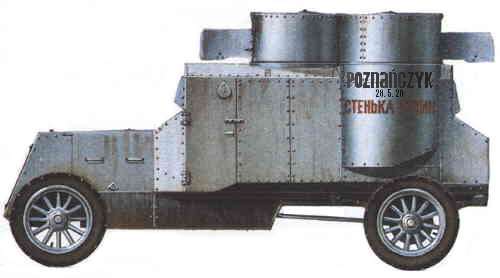Austin armoured cars
Part II: Austin armoured cars in the Polish Army / Armoured train "Związek Broni"
 |
| Polish Austin-Putilov "Poznańczyk" (captured Soviet "Styenka Razin"). [AJ] |
This page is about the Polish service of Austin armoured cars. Their development, variants, construction and usage in Russia and other countries are described in Part I.
Improvised armoured train "Związek Broni", 1918:
The first armoured car Austin in the Polish service was captured near Bobruysk by the troops of the 1st Polish Corps just in February 1918 (the 1st Polish Corps, of Gen. Józef Dowbór-Muśnicki, had been formed since August 1917 in Belarus, of the Poles serving in the Russian Army. It was supposed to fight on the Russian side, but after the revolution it was forced to fight against the Bolsheviks; finally it was disarmed by the Germans).
![Austin as a part of the 'Związek broni' armoured train [Photo source 2]](aust-zb2.jpg)
The captured Austin the 1st series had damaged rear suspension, so it was put upon a flatcar and used as a part of the Polish improvised armoured train "Związek Broni" ("United Arms").
This improvised armoured train was formed by the Poles in Bobruysk on 10 February 1918. It consisted of a regular locomotive and several freight wagons and flatcars, protected with sandbags and partially with armoured trench shields. The train's armament, apart from two machine guns of Austin, was one 76.2mm (3in) M.1902 field gun on a front flatcar, and several 7.62mm Maxim HMG's. Reportedly it had also 8 mortars, but without ammunition. The train's initiator and commander was Lt. Stanislaw Malagowski (later the commander of armoured train "Smialy"). The voluntary crew was at least 35 men.
During the first ten days the train took part in some skirmishes with the Bolsheviks. The first major action on Red Bereg (Krasny Bereg?) railway station took place on 21 February, with a succes. "The panic arose on the station, because our train's look was very threatening..." claimed the crew member. The photo was probably taken after this action. In the next months the train took part in further combat. On 10 May 1918 the train got into German hands, when the whole Corps was surrounded by the German Army and forced to demobilize.
 A sketch of the "Związek Broni"
A sketch of the "Związek Broni"
Polish-Soviet war 1919-20:
More Austin armoured cars were captured by the Polish units during 1919-1921 Polish-Soviet war:
 |
| Polish Austin the 3rd series, reportedly in 1920 near Brest on the Bug, pulled from a ditch by the troops after it protected the Poles against the Cossack attack, during Polish withdrawal [6] |
One Austin the 3rd series of the Soviet 10th Armoured Car Unit (avtobronyeotryad - ABO) was captured in August 1919 in Minsk by the 14th Infantry Division.
In March-April 1920 the Poles captured two cars Austin-Kegresse.
On 21 March, the Polish troops of the 26th Infantry Regiment were defending a bridgehead in Zwiahel (Novogrod Volynski) against Soviet infantry from the 58th Rifle Div. The Soviet attack was supported by the 6th ABO, commanded by I. Andreyev (it had 4 Austins-Kegresse: "Ukrainyets", "Putilovets", "Piterets", and one unknown). One Austin-Kegresse, named "Ukrainyets" ('the Ukrainian'), was hit and immobilized by a 76.2mm gun of a Polish heavy armoured car Garford named "Dziadek" ('Grandfather'), from "Dziadek" Autopluton (automobile platoon). The remaining two Soviet cars withdrew.
The second Austin-Kegresse of that unit, the "Putilovets" (name meaning 'the worker of Putilov Works'), was captured by the Poles on 26 April in Zytomierz (Zhitomir, Ukraine).
On the right up and below: abandoned "Ukrainyets" after the skirmish, and hauled by the Poles. The name is written in red under a turret. A slogan painted on the side in Cyrillic: "Vsya Vlast Sovyetam" means: "All the Power to the Councils".
(right up - [1], right below: [2,3])
Below: the second captured Austin-Kegresse - "Putilovets", with a name under a turret (possibly it had also a slogan "Smyert burzhuaziy" - "Death to the bourgeoisie"). On the left, a front part of the other Austin-Kegresse is visible. [3]. |
![Austin-Kegresse]](auskegr1.jpg) |
 |
 |
|---|
The former "Ukrainyets" was repaired and used in "Dziadek" platoon during the rest of the war, the former "Putilovets" was used in "Zagloba" platoon. One of cars was named "Lis" ('the Fox' - possibly the one from "Zagłoba" platoon). One was later given a number 4993 (most probably the other one). In the Polish service, they were sometimes also known as "półczołg" - literally: 'half-tank'. They were withdrawn in the late 1920's.
 |
 |
On the left - Austin-Kegresse "Lis" (name hardly visible on a plate before a driver).
On the right and below - Austin-Kegresse nr 4993 in the late 1920's. [6] |

|

|
|---|
 |
 |
|
Two color photos of Austin-Kegresse as a monument in Armoured Units Training Centre (CWBrPanc) in Modlin, taken in October 1939 (Hugo Jaeger). On the left side of the left photo, a monument with the TK-1 tankette can be seen. Click to enlarge. |
On 26 April 1920 the Poles captured also Austin the 3rd series in Zhitomir. The car surprisingly ran across Polish infantry on the street, causing much confusion, then it was chased through the town by Polish armoured cars Garford and Peerless. After being captured, it served with number 5302.
| On the right: Polish Austin the 3rd series, number 5309 (number painted in less typical way) [6] |

On 28 May 1920, the 55th Infantry Regiment of the 14th Wielkopolska Infantry Div. captured one Austin-Putilov near Bobruysk. It had Soviet name: "Styenka Razin" and belonged to the 1st avtobronyeotryad. It supported Soviet infantry, and then stuck in a ditch and was abandoned. Just after its capture, it was given a name "Poznańczyk" (of Poznań city) and was the first vehicle to constitute the newly created Wielkopolski Armoured Car Platoon. The car's (and platoon) comander was Lt. Feliks Peto. In July the platoon was fighting in retreat from Bobruysk, then was moved to Warsaw, where in August it was reformed into the 2nd Armoured Car Platoon.
On the right up - the captured "Styenka Razin" without its Polish name yet. The car was light grey, with red inscription "Styenka Razin". [2]
On the right - the car with a black name "Poznańczyk" painted on a side, above its old name and the date of capture. It was also painted on a slanted plate before the driver (see a title photo). Later (before August 1920?) the vehicle got also a white skull with bones painted on the front radiator plate [1] |
![Click to enlarge. [Photo source 1]](austinp3b.jpg) |
 |
In June 1920, the Polish troops from the 14th Infantry Div. captured one armoured car White with Austin the 1st series body, near Bobruysk. After repair, the car was included into the 2nd Armoured Car Platoon in August 1920 with the name: "Gen. Haller". |
| White "Gen. Haller" of the 2nd Platoon. On the right, Fiat-Izorski "Gen. Dowbor". [1] |
![Polish armoured car White 'Mars'. [Photo source 1]](white1.jpg)
The details about the second armoured car White with Austin the 1st series body are not known, but it served in the Polish Army with a name "Mars", nr. 4434. On the photos, the car is seen in the second half of 1920's, wearing a camouflage [6]. Both cars White were withdrawn in the late 1920's.

Four armoured cars of the Soviet 12th Army's Special (i.e: penal) Armoured Unit were captured on 11 September 1920 at Malorita near Kovel (now: Belarus). Probably at least two were Austin the II series. They were the last booty of this type.
 |
|---|
| Two Austins of the 2nd series, captured by the Polish. This is probably a photo of cars captured at Malorita. Note the nationality markings "RSFSR" (Russian Socialist Federal Soviet Republic). [1] |
The list above surely is not a complete one. Many combat episodes remained without evidence, and it is especially hard to find them today. Some of the cars were marked as an "unidentified type". This page is basing mainly on fundamental works of J. Magnuski in that field.
Further service 1921-1931:
Though the details are known only for some cars, but certainly in 1919-20 up to twenty armoured cars Austin of all variants were captured by the Polish. Most of them were used in combat then. The truce with the Soviet Russia was signed on 18 October 1920. At least 5 Austins were used after the war, until the late 1920's (the machine guns in the Polish vehicles might have been changed from 7.62mm Maxims to 7.92mm Maxim wz. 05/s or wz. 08 in the 1920's). The last car nr. 4432 was used for training in Modlin in 1931. Then, a wheeled Austin-Putilov and a half-track Austin-Kegresse were put as monuments in Modlin training centre (along with armoured cars Fiat-Izorski and Peerless) - they remained there until the Second World War and were captured by the Germans, their further fate is not known.

| The Polish parade in 1925 in Cracov - cars from the 5th Armoured Car Squadron. Two cars in front are most likely (from the right) Austin the 3rd and the 2nd series. Behind them is Austin-Putilov. Note the camouflage. [AJ] |
Polish Austin-Kegresse in autumn 1921, possibly in Poznań. Note a raised machine gun and the Polish early nationality mark on the side.
On the left a Garford heavy armoured car can be seen.
[2] |
![Polish Austin-Kegresse and Garford [Photo source 2]](auskegr2.jpg) |
Camouflage
There was no standard camouflage of the Polish vehicles at the time of the Polish-Soviet war. Cars were initially in original Soviet colors (usually grey, less likely dark green or dark olive). For example, Austin-Putilov "Poznańczyk", ex-"Stenka Razin", was grey.
After the Polish-Soviet war, from the mid-1920's the Polish vehicles were camouflaged in patches of several colours, with significant yellow (or light sand) colour. There was no standard pattern at that time, but it might be similar to Ford Tf-c.
Almost all vehicles had their own names, but only some are known. Apart from those mentioned above, one of the 2nd series Austins had a name "Jasiek" (Johny; there is a photo known of this vehicle in a camouflage).
In 1928 the Polish nationality mark was introduced, painted on the sides. It was the white and red shield, with slant division line. It was also appearing earlier (see 1921 photo above), in non-standardized style. During the Polish-Soviet war, the Polish cars had no standard
nationality marks.
Polish Austin-Putilov "Poznańczyk", ex-"Styenka Razin". The car was in original Soviet light grey painting, with red "Stenka Razin" inscription in Cyrilic. The new name "Poznańczyk" was painted in black, with a capture date. Polish name was also painted on the slant plate before the driver. Later (before August 1920?) the vehicle got a white skull with bones painted on the front radiator plate.
Drawing by Mikhail Dimitrev, modified by PIBWL. |  |
Sources:
1. Janusz Magnuski: "Samochody pancerne Wojska Polskiego 1918-1939"; Warsaw 1993
2. Jan Tarczyński: "Pojazdy w Wojsku Polskim - Polish Army vehicles 1918-1939", Pruszków 1995
3. "O Niepodległość i Granice 1914-1921", Editions Spotkania, 1990
6. Leonard Żyrkiewicz: "Samochody pancerne", W.I.N.-W., 1928
AJ - photos from a collection of Adam Jońca
Our thanks to Adam Jońca and Janusz
Top of the page
[ Main page ] [ Polish armour / armoured cars ]
[ Polish armoured units ] [ Steel Panthers ] [ Links ]
You can mail
me with any comments, additional information or photos.
All the photos and pictures remain the property of their owners. They are published in non-commercial educational and research purpose. Text copyright © Michal Derela.


![Austin as a part of the 'Związek broni' armoured train [Photo source 2]](aust-zb2.jpg)
 A sketch of the "Związek Broni"
A sketch of the "Związek Broni"
![Austin-Kegresse]](auskegr1.jpg)










![Click to enlarge. [Photo source 1]](austinp3b.jpg)

![Polish armoured car White 'Mars'. [Photo source 1]](white1.jpg)



![Polish Austin-Kegresse and Garford [Photo source 2]](auskegr2.jpg)
